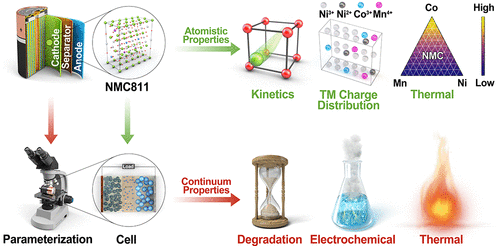当前位置:
X-MOL 学术
›
ACS Energy Lett.
›
论文详情
Our official English website, www.x-mol.net, welcomes your
feedback! (Note: you will need to create a separate account there.)
From Atoms to Cells: Multiscale Modeling of LiNixMnyCozO2 Cathodes for Li-Ion Batteries
ACS Energy Letters ( IF 19.3 ) Pub Date : 2021-12-03 , DOI: 10.1021/acsenergylett.1c02028 Lucy M. Morgan 1, 2 , Mazharul M. Islam 1, 2 , Hui Yang 2, 3 , Kieran O’Regan 2, 4 , Anisha N. Patel 2, 5 , Abir Ghosh 2, 5, 6 , Emma Kendrick 2, 4 , Monica Marinescu 2, 5 , Gregory J. Offer 2, 5 , Benjamin J. Morgan 1, 2 , M. Saiful Islam 1, 2 , Jacqueline Edge 2, 5 , Aron Walsh 2, 3, 7
ACS Energy Letters ( IF 19.3 ) Pub Date : 2021-12-03 , DOI: 10.1021/acsenergylett.1c02028 Lucy M. Morgan 1, 2 , Mazharul M. Islam 1, 2 , Hui Yang 2, 3 , Kieran O’Regan 2, 4 , Anisha N. Patel 2, 5 , Abir Ghosh 2, 5, 6 , Emma Kendrick 2, 4 , Monica Marinescu 2, 5 , Gregory J. Offer 2, 5 , Benjamin J. Morgan 1, 2 , M. Saiful Islam 1, 2 , Jacqueline Edge 2, 5 , Aron Walsh 2, 3, 7
Affiliation

|
First-generation cathodes for commercial lithium-ion batteries are based on layered transition-metal oxides. Research on ternary compounds, such as LiCoO2, evolved into mixed-metal systems, notably Li(Ni,Mn,Co)O2 (NMCs), which allows significant tuning of the physical properties. Despite their widespread application in commercial devices, the fundamental understanding of NMCs is incomplete. Here, we review the latest insights from multiscale modeling, bridging between the redox phenomena that occur at an atomistic level to the transport of ions and electrons across an operating device. We discuss changes in the electronic and vibrational structures through the NMC compositional space and how these link to continuum models of electrochemical charge–discharge cycling. Finally, we outline the remaining challenges for predictive models of high-performance batteries, including capturing the relevant device bottlenecks and chemical degradation processes, such as oxygen evolution.
中文翻译:

从原子到电池:用于锂离子电池的 LiNixMnyCozO2 阴极的多尺度建模
商用锂离子电池的第一代阴极基于层状过渡金属氧化物。对三元化合物的研究,如 LiCoO 2,演变成混合金属体系,特别是 Li(Ni,Mn,Co)O 2(NMC),它允许显着调整物理特性。尽管它们在商业设备中得到广泛应用,但对 NMC 的基本理解并不完整。在这里,我们回顾了多尺度建模的最新见解,将在原子水平上发生的氧化还原现象与离子和电子在操作设备中的传输联系起来。我们通过 NMC 组成空间讨论电子和振动结构的变化,以及这些变化如何与电化学充放电循环的连续模型联系起来。最后,我们概述了高性能电池预测模型的剩余挑战,包括捕获相关的设备瓶颈和化学降解过程,例如氧气释放。
更新日期:2022-01-14
中文翻译:

从原子到电池:用于锂离子电池的 LiNixMnyCozO2 阴极的多尺度建模
商用锂离子电池的第一代阴极基于层状过渡金属氧化物。对三元化合物的研究,如 LiCoO 2,演变成混合金属体系,特别是 Li(Ni,Mn,Co)O 2(NMC),它允许显着调整物理特性。尽管它们在商业设备中得到广泛应用,但对 NMC 的基本理解并不完整。在这里,我们回顾了多尺度建模的最新见解,将在原子水平上发生的氧化还原现象与离子和电子在操作设备中的传输联系起来。我们通过 NMC 组成空间讨论电子和振动结构的变化,以及这些变化如何与电化学充放电循环的连续模型联系起来。最后,我们概述了高性能电池预测模型的剩余挑战,包括捕获相关的设备瓶颈和化学降解过程,例如氧气释放。











































 京公网安备 11010802027423号
京公网安备 11010802027423号